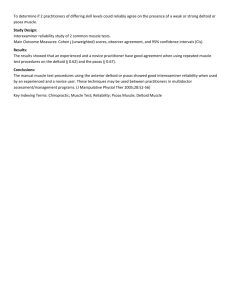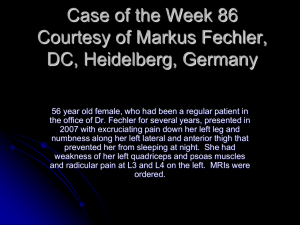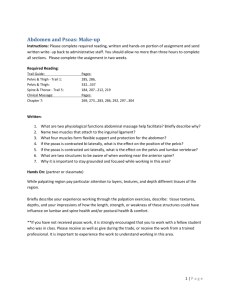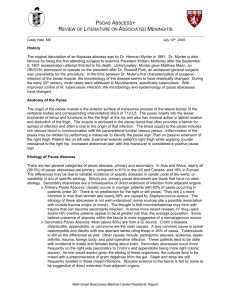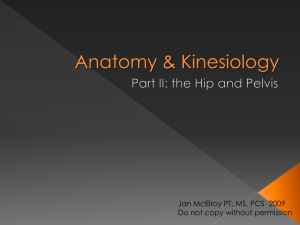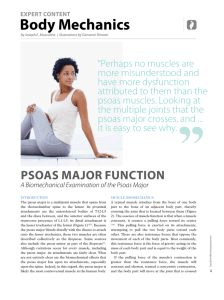Submission template for Capstone Project Case Report
advertisement
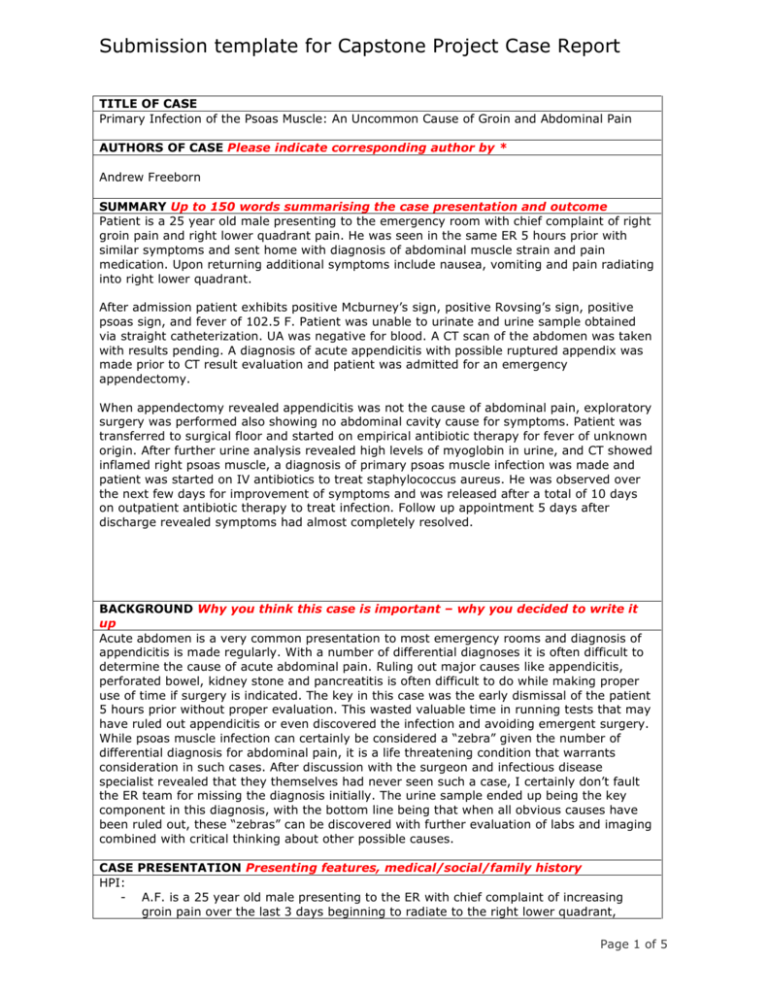
Submission template for Capstone Project Case Report TITLE OF CASE Primary Infection of the Psoas Muscle: An Uncommon Cause of Groin and Abdominal Pain AUTHORS OF CASE Please indicate corresponding author by * Andrew Freeborn SUMMARY Up to 150 words summarising the case presentation and outcome Patient is a 25 year old male presenting to the emergency room with chief complaint of right groin pain and right lower quadrant pain. He was seen in the same ER 5 hours prior with similar symptoms and sent home with diagnosis of abdominal muscle strain and pain medication. Upon returning additional symptoms include nausea, vomiting and pain radiating into right lower quadrant. After admission patient exhibits positive Mcburney’s sign, positive Rovsing’s sign, positive psoas sign, and fever of 102.5 F. Patient was unable to urinate and urine sample obtained via straight catheterization. UA was negative for blood. A CT scan of the abdomen was taken with results pending. A diagnosis of acute appendicitis with possible ruptured appendix was made prior to CT result evaluation and patient was admitted for an emergency appendectomy. When appendectomy revealed appendicitis was not the cause of abdominal pain, exploratory surgery was performed also showing no abdominal cavity cause for symptoms. Patient was transferred to surgical floor and started on empirical antibiotic therapy for fever of unknown origin. After further urine analysis revealed high levels of myoglobin in urine, and CT showed inflamed right psoas muscle, a diagnosis of primary psoas muscle infection was made and patient was started on IV antibiotics to treat staphylococcus aureus. He was observed over the next few days for improvement of symptoms and was released after a total of 10 days on outpatient antibiotic therapy to treat infection. Follow up appointment 5 days after discharge revealed symptoms had almost completely resolved. BACKGROUND Why you think this case is important – why you decided to write it up Acute abdomen is a very common presentation to most emergency rooms and diagnosis of appendicitis is made regularly. With a number of differential diagnoses it is often difficult to determine the cause of acute abdominal pain. Ruling out major causes like appendicitis, perforated bowel, kidney stone and pancreatitis is often difficult to do while making proper use of time if surgery is indicated. The key in this case was the early dismissal of the patient 5 hours prior without proper evaluation. This wasted valuable time in running tests that may have ruled out appendicitis or even discovered the infection and avoiding emergent surgery. While psoas muscle infection can certainly be considered a “zebra” given the number of differential diagnosis for abdominal pain, it is a life threatening condition that warrants consideration in such cases. After discussion with the surgeon and infectious disease specialist revealed that they themselves had never seen such a case, I certainly don’t fault the ER team for missing the diagnosis initially. The urine sample ended up being the key component in this diagnosis, with the bottom line being that when all obvious causes have been ruled out, these “zebras” can be discovered with further evaluation of labs and imaging combined with critical thinking about other possible causes. CASE PRESENTATION Presenting features, medical/social/family history HPI: - A.F. is a 25 year old male presenting to the ER with chief complaint of increasing groin pain over the last 3 days beginning to radiate to the right lower quadrant, Page 1 of 5 - - nausea/vomiting, and difficulty urinating. Patient was seen 5 hours prior in same ER with similar symptoms but no nausea or vomiting. A diagnosis of abdominal/groin strain was made at that time and the patient was sent home with pain medication. Vitals at time of admission were: Temperature 102.5 F, HR 126, BP 138/84, Respirations 24, Pain 10/10 Patient exhibited positive Rovsing’s sign, positive Mcburney’s sign, and positive psoas sign. Patient was treated with Dilaudid for pain and further investigations were begun PMH: - No significant past medical history. Patient had no chronic illnesses, had never undergone surgery, and was never hospitalized for any reason. Meds: None Allergies: Pet dander Family Hx: - positive for diabetes (maternal grandfather), hypertension (father, maternal grandfather), dyslipidemia (mother, father and maternal grandfather), and breast cancer (paternal grandmother) Social Hx: - occasional EtOH and tobacco use, no illicit drug use - student in Central Michigan University PA program ROS: - General: Patient presents in obvious distress with possibility of sepsis based on vitals, no significant medical history - Cardiac: No prior issues, tachycardic upon admission - Respiratory: No prior issues, slightly tachypnic upon admission - GI/Abdomen: See HPI - GU: No prior issues, difficulty urinating at time of admission PE: - Vitals at admission: Temp 102.5, HR 126, BP 138/84, Resp 24, Pain 10/10 - General: Patient appears toxic, in acute distress, responsive during interview and PE - Skin: pale, cool and clammy - HEENT: WNL - Heart: HR 126, tachycardic, no murmurs - Lungs: CTA bilaterally - Abdomen: Positive Rovsing’s sign, positive Mcburney’s sign, positive psoas sign, very tender to palpation, non-distended, no organomegally - GU: WNL - Neurologic: WNL, patient is responding to all questions - Extremities: Pain in RLQ with extension of right hip, otherwise WNL INVESTIGATIONS If relevant Imaging: - AXR negative for renal calculi or abnormal bowel findings - CT reveals severe inflammation of R psoas muscle (evaluated post-op) - MRI reveals no abscess formation in R psoas compartment (performed post-op) - Ultrasound of gallbladder negative for gallstone or bile duct obstruction Laboratory Studies: - UA reveals high levels of myoglobin (this was discovered post-op) - CBC reveals WBC count of 18,000 - Inflammatory markers reveal elevated ESR and CRP - BMP within normal limits - Blood cultures negative Surgery: - Emergency appendectomy revealed small appendicolith determined not to be the cause of severe abdominal pain, further exploration revealed no bowel perforation or obvious infection in abdominal cavity causing abdominal pain. Surgery was performed prior to results Page 2 of 5 of CT or further urine analysis. DIFFERENTIAL DIAGNOSIS If relevant - Appendicitis/Ruptured appendix - Renal calculi - Perforated bowel - Small bowel obstruction - Gallstone/Biliary obstruction - Pancreatitis TREATMENT If relevant Patient was initially treated with broad spectrum empiric antibiotics to cover gram positive and gram negative bacteria, specifically IV ampicillin and gentamicin. As white blood cell count began to subside patient was switched to IV Unasyn and vancomycin for Staphylococcus aureus coverage. This was found to be the etiological agent in most psoas muscle infections. Over the course of the next several days treatment was showed to be working in decreasing both WBC count and fever. After discharge patient was treated with IV vancomycin over 5 days (via PIC line) followed by a course of doxycycline 4 times daily for 10 days. OUTCOME AND FOLLOW-UP Patient was hospitalized for a total of 10 days, being monitored for several days d/t continued fever and elevated WBC count, as well as no specific diagnosis until 2 days after abdominal surgery. Etiologic agent was never clinically discovered, but was assumed to be Staphylococcus aureus both d/t response to treatment and research of most cases of primary psoas muscle infection. Patient was discharged when WBC count and fever were stabilized and antibiotic treatment was found to be therapeutic. Patient followed up 5 days post-discharge with surgeon who performed operation and was found to be doing well though still experiencing some groin pain and difficulty walking. After completion of antibiotic therapy patients symptoms completely resolved over the course of the next 3-4 weeks. DISCUSSION including very brief review of similar published cases (how many similar cases have been published?) 1. Guidelines for diagnosis and management protocol for primary and secondary psoas muscle infection/psoas abscess 2. How common are psoas muscle abscesses/infections? 3. What are the most common etiologic agents found in psoas muscle abscesses/infections? 1. Psoas infections and abscesses are extraordinarily rare and are therefore often not considered as a cause for acute abdominal or groin pain. They are classified as either primary (stemming from a particular source in the body) or secondary (the result of underlying disease states like Crohn’s disease or post-surgical infections). Clinical signs and symptoms are similar to many other causes of abdominal pain, specifically appendicitis, and there is no particular sign or symptom that is specific to this condition. Because this issue can be confused with so many other conditions, it is important to piece together several components when making a diagnosis. This means coupling common presenting signs and symptoms with diagnostic imaging and laboratory studies, and ruling out common causes of acute abdominal pain. 2 The most common presenting signs of psoas infection are flank pain, diffuse abdominal pain, fever, limp and weight loss. One key sign in this diagnosis is the position of most comfort for the patient. This will be laying supine with the knee bent and hip externally rotated on the affected side. In this position the least amount of strain is being put on the psoas muscle, the prominent flexor muscle of the hip. Signs often elicited for acute appendicitis will also be positive in this condition because of the proximity of the Page 3 of 5 psoas muscle to the appendix anatomically. The most specific sign for psoas infection is the psoas sign, elicited by hyperextending and externally rotating the hip or by asking the patient to flex the hip against resistance. This test will cause extreme pain to the patient, perhaps even more so than in a patient with acute appendicitis, although the difference is not measurable. 2 Diagnostic studies are controversial in terms of their ability to diagnose psoas muscle infection. The only study said to be a gold standard in diagnosis is a CT scan of the abdomen, though some argue an MRI is more beneficial in terms of its ability to view abscess walls if an abscess has formed. ESR and CRP will often be elevated as inflammatory markers, CBC will often show elevated WBC count, and blood cultures may reveal the causative bacteria if sepsis has occurred. Abdominal ultrasound may be helpful but it is often difficult to visualize abdominal structures. CT and MRI are most helpful in identifying swelling, inflammation, and location of any abscesses that may have formed. Of the articles I researched there was no mention of urine analysis revealing high levels of myoglobin (indicating rhabdomyolysis), though this was a key component in the diagnosis in this particular patient. 4,5 Once the diagnosis of psoas muscle infection or abscess is made, the treatment is dependent upon the bacterial agent causing the infection. If an abscess has formed it often must be drained surgically. In primary psoas infections the most prominent agent is staphylococcus and anti-staphylococcal therapy, like vancomycin or doxycycline, should be initiated. In secondary infections the most common bacteria are enteric, and broad spectrum antibiotic therapy should be initiated, often clindamycin, a penicillin and an aminoglycoside, as well as Flagyl. 3 2. The diagnosis of psoas muscle infection or abscess remains a very rare phenomenon. A total of 434 cases have been reported 3. In the early 20th century most psoas abscesses arose as a result of the spread of M. tuberculosis in patients with Pott’s disease (TB of the spine). Since the eradication of TB in the Western world psoas infections have declined. In 1992 it was reported that there were 12 cases of psoas abscess worldwide, which was actually an increase from 3.9 per year as of 1985. 3,4 While in underdeveloped countries the majority of diagnoses remain primary, in the Western world the majority of cases we see are secondary, due to post surgical infection or underlying GI disease, particularly Crohn’s disease. It is also notable that the majority of primary infections seen worldwide occur in the younger population, often under the age of 30, while the older population (over 40) is more susceptible to secondary infections. This is most likely due to the fact that secondary infections occur in patients who undergo surgery or have and underlying disease state (Crohn’s, diverticulitis, diabetes mellitus, etc.) and these are likely to be older patients. 4 While it remains an extremely rare diagnosis, psoas muscle infections are believed to be under-reported in most countries. This is controversial and many believe the lack of reporting, while decreasing known incidence worldwide, is being offset by the development of more readily available diagnostic imaging, mainly CT and MRI 5. 3. The most common etiologic agent in primary psoas muscle infections and abscesses is Staphylococcus aureus, from hematogenous spread, found in 88% of positive blood cultures 1. Secondary infections, occurring more often in the elderly population, are most often caused by staphylococcus species at 4.9% and E. coli at 2.8 % 1. Mycobacterium tuberculosis is still seen in developing countries, but is rarely seen anymore in the Western world and developed countries as a causative agent. Other agents identified in causing both primary and secondary infections are bacteroides, clostridium, klebsiella, MRSA, and salmonella. 1,4,5 The importance of understanding the most common agents causing such an infection is obviously in choosing the appropriate antibiotic therapy. Empiric therapy is often recommended prior to identifying the causative agent through blood culture or abscess aspiration 4. If primary infection is suspected, anti-staphylococcal agents are recommended. In secondary infection broad spectrum antibiotics are indicated to treat both staphylococcal and enteric bacteria. LEARNING POINTS/TAKE HOME MESSAGES 3 to 5 bullet points - While certainly a rare cause of acute abdominal pain, the diagnosis of psoas muscle infection or abscess is a serious one requiring immediate antibiotic therapy and possibly surgical drainage immediately. Failure to treat this infection quickly can Page 4 of 5 result in sepsis and eventually death and the difficulty in making a diagnosis of psoas infection further increases these risks. It should be considered in cases where common conditions have been ruled out and further investigation is warranted. - This condition mimics appendicitis in nearly all aspects of diagnosis and in this case resulted in unnecessary surgery. If appendicitis can be ruled out prior to surgery by thorough diagnostic testing, a difficult decision to make if perforation or rupture of the appendix is suspected, a high suspicion of this condition is warranted. - Think outside of the box when common conditions have been ruled out. These “zebras” are out there and being able to suspect and test for such a rare cause of abdominal pain can save a life in the long run. In this case a simple thorough urine analysis provided the key clue to making the diagnosis. REFERENCES 1. Gezer A., Erkan S., Erzik B.S., & C.T. Erel (2004). Primary psoas muscle abscess diagnosed and treated during pregnancy: Case report and literature review. Infect Dis Obstet Gynecol, 12:147-149 2. Mallick I.H, Thoufeeq M.H., & T.P. Rajendran (2004). Iliopsoas abscesses: A Review. Postgrad Med J, 80:459-462 3. Riyad Y.M., Sallam M.A., & A. Nur (2003). Pyogenic psoas abscess: Discussion of its epidemiology, etiology, bacteriology, diagnosis, Treatment and prognosis: A Case Report. Kuwait Med J, 35(1):44-47 4. van den Berge M., de Marie S., Kuipers T., Jansz A.R, & B. Bravenboer (2005). Psoas abscess: Report of a series and review of the literature. The Netherlands Journal of Medicine, 63(10):413-416 5. Yin H.P., Tsai Y.A., Liao S.F., Lin P.H., & T.Y. Chuang (2004). The challenge Of diagnosing psoas abscess: A Case Report. J Chin Med Assoc, 67:156-159 Date: 10/31/2008 PLEASE SAVE YOUR TEMPLATE WITH THE FOLLOWING FORMAT: Author’s last name and date of submission, eg, Smith_June_2008.doc Page 5 of 5
